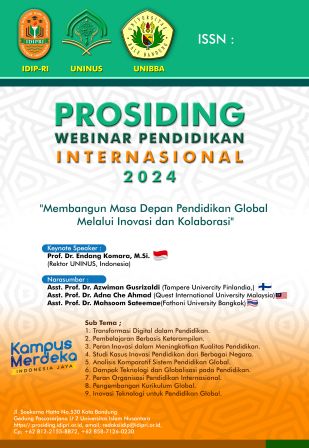A GEOGRAPHICAL ANALYSIS OF THE LOW INTEREST OF HIGH SCHOOL GRADUATES TO CONTINUE THEIR EDUCATION TO UNIVERSITY
Abstract
This research is motivated by the small population of college graduates in Babakan Village, Ciparay Subdistrict, Bandung Regency. This is caused by many factors, including geography and economic factors, resulting in low interest among high school graduates to continue their education to higher education. This research uses a descriptive analysis method with a quantitative approach. The population in this study were high school graduates in 2021, 2022, and 2023 in Babakan Village, and the sample was 36 people. The study results are to know the population of high school graduates / equivalent classes of 2021, 2022, and 2023 in Babakan village and to know what factors influence the low interest in continuing education to higher education. This research concludes that the factors that influence the interest of high school / equivalent graduates to continue their education to higher education are caused by graphical factors, including the distance from home to the place of study is very far and the lack of public transportation tools available in Babakan Village so that it causes difficulty in access to the place of study. Family socioeconomic factors, including the low level of parents’ income, cause the inability to pay for their children to continue their studies so that parents immediately direct their children after graduating from high school / equivalent to work rather than continuing their education to higher education.
Keywords: Geographical Analysis, Interest, To Continue, Higher Education
References
Arikunto, S. (2013). Prosedur Penelitian: Suatu Pendekatan Praktik. Jakarta: Rineka Cipta
Arnawan, I. G. (2016). Faktor Penyebab Kurangnya Minat Remaja Desa terhadap Pendidikan Di Perguruan Tinggi (Studi Kasus Pada Remaja di Desa Balirejo Kecamatan Angkona Kabupaten Luwu Timur). Jurnal Sosialisasi: Jurnal Hasil Pemikiran, Penelitian Dan Pengembangan Keilmuan Sosiologi Pendidikan, 80–84.
Hasanah, U., & Deiniatur, M. (2019). Character education in early childhood based on family. (ECRJ) Early Chilhood Research Journal, 7(1), 29–42. https://doi.org/10.26418/jvip.v7i1.333
Indriyanti, N., & Ivada, E. (2013). Faktor-Faktor Yang Memengaruhi Minat Melanjutkan Pendidikan Ke Perguruan Tinggi Pada Siswa Kelas XII Akuntansi SMK Negeri 6 Surakarta Tahun 2013. Jupe-Jurnal Pendidikan Ekonomi, 1(2).
Nabilah M (2023). Tamatan Tingkat Pendidikan Warga Indonesia Terbanyak dari SMA pada Maret 2023. https://databoks.katadata.co.id/datapublish/2023/11/27/tamatan-tingkat-pendidikan-warga-indonesia-terbanyak-dari-sma-pada-maret-2023.
Sari, W., Rifki, A. M., & Karmila, M. (2020). Analisis kebijakan pendidikan terkait implementasi pembelajaran jarak jauh pada masa darurat covid 19. Jurnal Mappesona, 3(2).
Slameto (2015). Belajar dan Faktor-Faktor Yang Mempengaruhinya. Jakarta: PT.Rineka Cipta
Sugiyono. (2016). Metode Penelitian Kuantitatif, Kualitatif dan R&D. Bandung: PT Alfabeta
Suib, M. S. (2017). Sinergitas Peran Pondok Pesantren Dalam Peningkatkan Indek Pembangunan Manusia (IPM) di Indonesia. Jurnal Islam Nusantara, 1(2)
Undang-undang Nomor 12 Tahun 2012. Tentang Pendidikan Tinggi.






